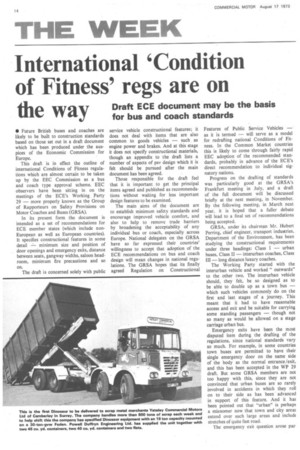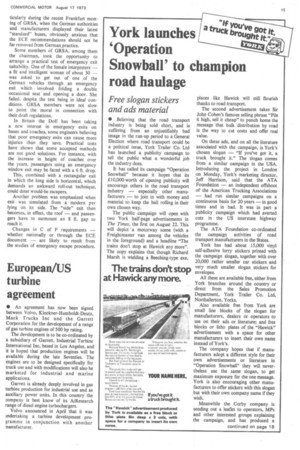International 'Condition of Fitness' regs are on the way
Page 16

Page 17

If you've noticed an error in this article please click here to report it so we can fix it.
Draft ECE document may be the basis for bus and coach standards
• Future British buses and coaches are likely to be built to construction standards based on those set out in a draft document which has been produced under the auspices of the Economic Commission for Europe.
This draft is in effect the outline of international Conditions of Fitness regulations which are almost certain to be taken up by the EEC Commission as a bus and coach type approval scheme. EEC observers have been sitting in on the meetings of the ECE's Working Party 29 — more properly known as the Group of Rapporteurs on Safety Provisions on Motor Coaches and Buses (GRSA).
In its present form the document is intended as a set of recommendations for ECE member states (which include nonEuropean as well as European countries). It specifies constructional features in some detail minimum size and position of door openings and emergency exits, distance between seats, gangway widths, saloon headroom, minimum fire precautions and so on.
The draft is concerned solely with public service vehicle constructional features; it does not deal with items that are also common to goods vehicles — such as engine power and brakes. And at this stage it does not specify constructional materials, though an appendix to the draft lists a number of aspects of psv design which it is felt should be pursued after the main document has been agreed.
Those responsible for the draft feel that it is important to get the principal items agreed and published as recommendations without waiting for less important design features to be examined.
The main aims of the document are to establish minimum safety standards and encourage improved vehicle comfort, and also to help to remove trade barriers by broadening the acceptability of any individual bus or coach, especially across Europe. National delegates on the GRSA have so far expressed their countries' willingness to accept that adoption of the ECE recommendations on bus and coach design will mean changes in national regulations. The GRSA hopes that its finally agreed Regulation on Constructional Features of Public Service Vehicles — as it is termed — will serve as a model for redrafting national Conditions of Fitness. In the Common Market countries this is likely to come through fairly rapid EEC adoption of the recommended standards, probably in advance of the ECE's direct recommendation to individual signatory nations.
Progress on the drafting of standards was particularly good at the GRSA's Frankfurt meeting in July, and a draft of the full document will be discussed briefly at the next meeting, in November. By the following meeting, in March next year, it is hoped that a fuller debate will lead to a final set of recommendations being accepted.
GRSA, under its chairman Mr. Hubert Perring, chief engineer, transport industries, Department of the Environment, has been studying the constructional requirements under three headings: Class I — urban buses, Class II — interurban coaches, Class III — long distance luxury coaches.
The Working Party started with the interurban vehicle and worked " outwards" to the other two. The interurban vehicle should, they felt, be so designed as to be able to double up as a town bus — which such vehicles commonly do on the first and last stages of a journey. This meant that it had to have reasonable access and exit and be suitable for carrying some standing passengers — though not so many as would be allowed on a stage carriage urban bus.
Emergency exits have been the most disputed item during the drafting of the regulations, since national standards vary so much. For example, in some countries town buses are permitted to have their single emergency door on the same side of the body as the normal entrance /exit, and this has been accepted in the WP 29 draft. But some GRSA members are not too happy with this, since they are not convinced that urban buses are so rarely involved in accidents in which they roll on to their side as has been advanced in support of this feature. And it has been pointed out that "urban" is perhapE a misnomer now that town and city are at extend over such large areas and incluck stretches of quite fast road.
The emergency exit question arose par
ticularly during the recent Frankfurt meeting of GRSA, when the German authorities and manufacturers displayed their latest "standardbuses, obviously anxious that the ECE recommendations should not be far removed from German practice.
Some members of GRSA, among them the chairman, took the opportunity to arrange a practical test of emergency exit suitability. One of the female interpreters — a fit and intelligent woman of about 30 was asked to get out of one of the German vehicles through an emergency exit which involved folding a double occasional seat and opening a door. She failed, despite the test being in ideal conditions. GRSA members were not slow to point the moral in connection with their draft regulations.
In Britain the DoE has been taking a new interest in emergency exits on buses and coaches, some engineers believing that poor emergency exits can cause more injuries than they save. Practical tests have shown that some accepted methods are not good solutions. For instance, with the increase in height of coaches over the years, passengers using an emergency window exit may be faced with a 6 ft. drop.
This, combined with a rectangular exit in which the long side is horizontal, which demands an awkward roll-out technique, could deter would-be escapers.
Another problem was emphasized when exit was simulated from a modern psv lying on its side. The "side" exit then becomes, in effect, the roof — and passengers have to surmount an 8 ft. gap to reach it.
Changes in C of F requirements — whether nationally or through the ECE document -are likely to result from the studies of emergency escape procedure.
































































































